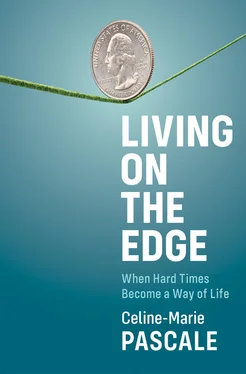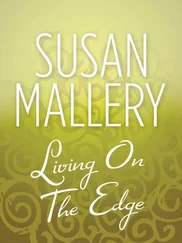When politicians boast of a strong economy and a low unemployment rate, they mask the reality of working people’s lives. A more accurate assessment of the quality of life experienced by millions of people needs to focus on self-sufficiency and underemployment. It would seem fairly basic to recognize that any person who has full-time work and does not earn enough to meet baseline living expenses is underemployed. I would also argue that they are underemployed if they don’t have the economic stability to cover unexpected expenses like car repairs. How well our families are doing depends not only on what we are earning but also on what we are spending – most especially on housing.
Framework 2: Housing – Fair Market Rent vs Affordable Housing
Across the country, the cost of housing is rising faster than wages. A study of US government data by the United Way Alice Project shows that 43% of all households “can’t afford a basic monthly budget for housing, food, transportation, childcare, health care and a monthly smartphone bill.” 19The US Department of Housing and Urban Development (HUD) considers anyone who pays more than 30% of their income on housing to be cost burdened. 20Yet HUD’s own figures show that millions of households spend between 50% and 70% of their income on housing. The widening gap between income and housing costs has created a crisis for families across the nation. Just fifty years ago, it would have been unimaginable that hundreds of thousands – by some counts millions – of people in the US would be unable to afford housing. Yet the rise of tent cities that began in the 1980s has become a living testimony to the pervasive lack of affordable housing. The cost of housing obviously compounds the problem of low wages.
In 1974 HUD developed the concept of Fair Market Rent (FMR) in order to determine standardized payments for their housing voucher program, known as Section 8 Housing, to support extremely low-income families. HUD determines FMR for an area and provides a rent subsidy so that families pay only 30% of their annual income on rent. That’s how it works in theory. In 2018, 3 million families were on voucher waitlists. 21In 2019 only seventeen states had any open waitlists at all. Yet HUD continues to conduct surveys to determine FMR, and since its numbers are widely used by other organizations concerned with rental costs, it is worth understanding what is meant by FMR.
HUD uses regional surveys of rent and designates rents falling in the 40th percentile as FMR. This means that 40% of rents are either at or less expensive than the FMR and 60% are more expensive. 22As bad as that might sound, even FMRs tend to be out of reach for many. For example, a survey by the National Low Income Housing Coalition found that on a minimum-wage salary, it is impossible to afford fair market rent for a one-bedroom apartment in all but twenty-two of the nation’s 3,000 counties. 23And there is no relief in sight. In 2019 the White House proposed to slash $8.8 billion from HUD’s most important programs and to loosen the caps on rents for landowners enrolled in the federal voucher program. 24
The government, nonprofits, and businesses also use a term called “affordable housing” to describe housing for which the total cost of rent (or mortgage) plus utilities is no more than 30% of one’s pre-tax income. It makes sense that the government thinks in terms of money when considering what counts as affordable housing. That is the easiest calculation for affordability, but it isn’t exactly right. It doesn’t, for example, take into account things like the quality of the housing, neighborhood schools, public safety, and public transportation. A family might find housing they can afford but that requires a long commute for work. A long commute then increases the length of the workday, the cost of transportation, and the cost of childcare. In addition, living in one community and working in another adds more stressors, like not being able to get to the children’s school if there is an emergency. None of these factors fit neatly into the spreadsheets used to calculate affordable housing.
In an effort to provide affordable housing to residents, cities have tried two strategies: rent control and inclusionary housing. Rent control limits how much landlords can increase rent in any given year; yet, as of 2019, only five states 25had cities with some form of rent control. Rent control legislation varies with respect to evictions. For example, under California’s rental laws, owners can evict tenants without cause by providing a written notice. Once a unit is vacated, owners can increase the rent without restriction. Overall, rent control has proven to be of limited use because it applies only to older buildings and often provides a disincentive for owners to maintain the property.
According to the National League of Cities, about 800 cities have mandated “inclusionary housing” or “opportunity housing.” 26While the details vary by city, the general idea is that developers are required to set aside some percentage of new housing for rent at below the open market rent. Cities provide developers with tax credits for these set asides, which are generally 15% of the development. 27(Just as tax credits vary, so do the required set asides. In some areas developers might be required to set aside as little 5% or as much as 25% of the rental property.) 28Often inclusionary housing is more expensive than FMR. Price points are based on 40–60% of the area median income and rentals are allocated on a lottery system. For communities, inclusionary housing helps to break down economic segregation and can make good neighborhoods more accessible. However, cities’ efforts to find a way to balance local income and local housing costs leave many frustrated. Some developers argue that despite the tax breaks, inclusionary housing laws make it hard for them to recoup their investments. Renters face a lottery system in which hundreds (sometimes thousands) of people apply for a single unit. For many struggling families, in any case, the so-called affordable housing is completely unaffordable.
While government efforts to subsidize rentals (Section 8 housing vouchers, low-income housing tax credit, and public housing) are expensive, the federal government actually spends more on subsidies for homeowners than it does for renters. 29Housing subsidies for homeowners come in the form of deductions for mortgage interest, real estate tax, and tax exclusions on capital gains from sales and accelerated depreciation (for owners of rental apartments). In 2015, these deductions for homeowners were more than double the combined costs of all federal subsidized rentals. Long story short, families are left to shoulder the burden of rising rents. 30The US has yet to address the housing crisis that drives families into poverty and too often into homelessness. Throughout my year of travel, I did not meet anyone who paid FMR – everyone paid more for rent and everyone felt the burden of rent in different ways. For some it meant having to live in shared housing, for others it meant being hard pressed to manage monthly bills, and for still others it meant not being able to afford to retire. Yet HUD’s calculation of FMR is the only standard measure of market rents available and, as we will see in the next section, it is used for other budget calculations.
Framework 3: Poverty – The Federal Poverty Line vs Self-sufficiency Budget
As a nation, we use the federal poverty line to set a threshold, an economic floor , for living standards. 31The federal government uses this threshold in two ways: first to determine whether or not a person or family qualifies for assistance, and then again to calculate the number of people who live in poverty. In 2018, the federal threshold for poverty was a pre-tax income of $12,140 for an individual. For a family of two, the poverty line creeps up to $16,460; for a family of three it moves to $20,780; and for a family of four to $25,100. By this standard, nationwide about 40 million people live in poverty; of those, 18.5 million live in extreme poverty and 5.3 million live in conditions of absolute poverty that we associate with the developing world. 32This is shocking to think about. And the reality of lived poverty is even worse. Anyone living and working in the United States knows the federal poverty line sets an unrealistic definition of poverty. Clearly the government has to know this, too.
Читать дальше












